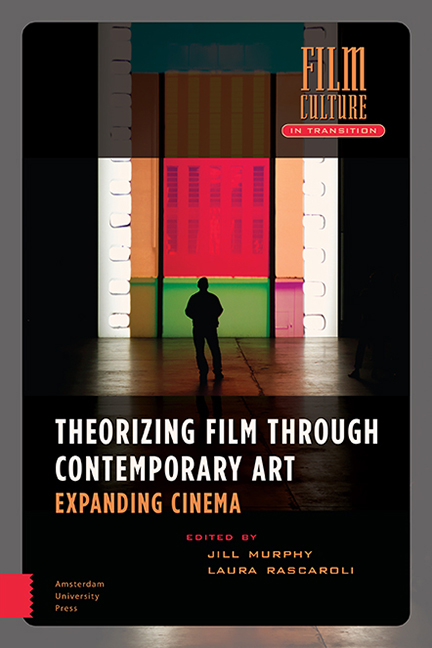Book contents
- Frontmater
- Dedication
- Contents
- List of Illustrations
- Acknowledgments
- Foreword: Courtesy of the Artists
- Introduction: On Cinema Expanding
- Part One Materialities
- 1 Cinema as (In)Visible Object; Looking, Making, and Remaking
- 2 Objects in Time; Artefacts in Artists’ Moving Image
- 3 Materializing the Body of the Actor; Labour, Memory, and Storage
- 4 How to Spell ‘Film’; Gibson + Recoder’s Alphabet of Projection
- Part Two Immaterialities
- 5 The Magic of Shadows; Distancing and Exposure in William Kentridge’s More Sweetly Play the Dance
- 6 Douglas Gordon and the Gallery of the Mind
- 7 A Throw of the Dice Will Never Abolish Chance; Tacita Dean’s Section Cinema (Homage to Marcel Broodthaers)
- Part Three Temporalities
- 8 The Photo-Filmic Diorama
- 9 The Cinematic Dispositif and Its Ghost; Sugimoto’s Theaters
- 10 Time/Frame: On Cinematic Duration
- Part Four The Futures of the Image
- 11 Interactivity without Control; David OReilly’s Everything (2017) and the Representation of Totality
- 12 Post-Cinematic Unframing
- 13 Absolute Immanence
- Index
1 - Cinema as (In)Visible Object; Looking, Making, and Remaking
Published online by Cambridge University Press: 23 June 2021
- Frontmater
- Dedication
- Contents
- List of Illustrations
- Acknowledgments
- Foreword: Courtesy of the Artists
- Introduction: On Cinema Expanding
- Part One Materialities
- 1 Cinema as (In)Visible Object; Looking, Making, and Remaking
- 2 Objects in Time; Artefacts in Artists’ Moving Image
- 3 Materializing the Body of the Actor; Labour, Memory, and Storage
- 4 How to Spell ‘Film’; Gibson + Recoder’s Alphabet of Projection
- Part Two Immaterialities
- 5 The Magic of Shadows; Distancing and Exposure in William Kentridge’s More Sweetly Play the Dance
- 6 Douglas Gordon and the Gallery of the Mind
- 7 A Throw of the Dice Will Never Abolish Chance; Tacita Dean’s Section Cinema (Homage to Marcel Broodthaers)
- Part Three Temporalities
- 8 The Photo-Filmic Diorama
- 9 The Cinematic Dispositif and Its Ghost; Sugimoto’s Theaters
- 10 Time/Frame: On Cinematic Duration
- Part Four The Futures of the Image
- 11 Interactivity without Control; David OReilly’s Everything (2017) and the Representation of Totality
- 12 Post-Cinematic Unframing
- 13 Absolute Immanence
- Index
Summary
Abstract
Through a focus on Runa Islam's installation Cabinet of Prototypes (2009–2010), but drawing on the work of Tobias Putrih, Janet Cardiff, and George Bures Miller among others, this essay explores the commitment to displaying the objectness of historical cinema and its filmic apparatus in contemporary art. It argues that in setting up tangible, specific ways to look at the medium of cinema, the artistic practice of artists such as Islam effectively offers a theorization of cinema itself for the age of its obsolescence. Art practices, such as Islam’s, that are simultaneously a kind of curation of cinema constitute not only a way of reflecting on the medium's historicity, but also of experimenting with its possible reemergence as something other than its historical self.
Keywords: Obsolescence, cinema architecture, materiality, film installation, contemporary art, film theory
In the first half of the twentieth century, critics and historians including Walter Benjamin, André Bazin, and Lewis Mumford were enthused by the relatively new medium of cinema and saw it as part of technological developments augmenting and transforming – if not, even more radically, replacing – the function of the museum as a venue for the preservation and exhibition of art and artefacts. In its supple, reproducible, and transportable materiality, cinema might, so to speak, give wings to the cumbersome materiality of unique works of art and grant them wider circulation and greater visibility: it might contribute to engender what André Malraux, referring to photography, famously described as a ‘museum without walls’. Yet, by the close of the last century, it seemed that, rather than taking the place of the museum and overcoming its walls, cinema had, by contrast, firmly taken its place in it – installing itself with particular prominence in art museums and galleries in the wake of a turn towards the cinematic in contemporary art practice. If the situation contradicted early-twentieth-century forecasts or hopes, it was also somewhat paradoxical. By some accounts, cinema itself was now deemed to be in the throes of obsolescence – losing, in the wake of the diffusion of digital formats and portable devices, its original filmic materiality and its traditionally collective, yet anonymous, mode of consumption.
- Type
- Chapter
- Information
- Theorizing Film Through Contemporary ArtExpanding Cinema, pp. 49 - 68Publisher: Amsterdam University PressPrint publication year: 2020



